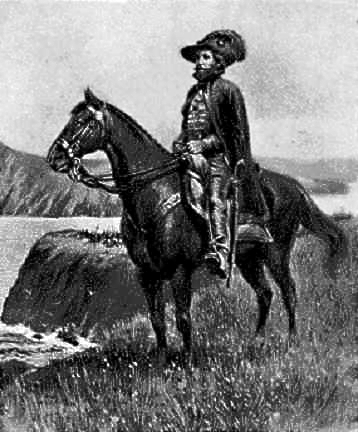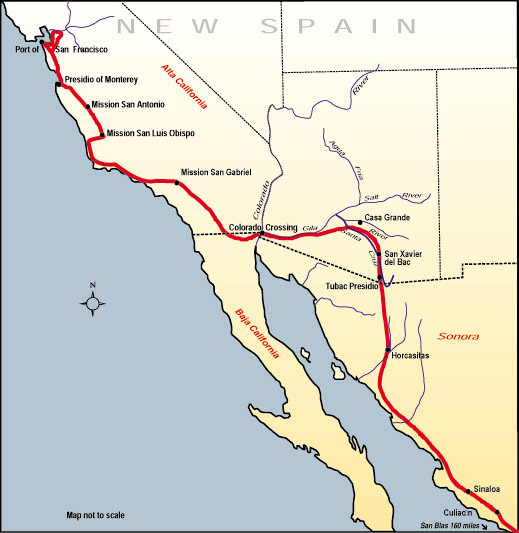
Juan Bautista de Anza, from a portrait in oil by Fray Orsi in 1774
On March 28, 1776, Basque New-Spanish explorer Juan Bautista de Anza was the first to reach the San Francisco Bay by land. De Anza was the first European to establish an overland route from Mexico, through the Sonoran Desert, to the Pacific coast of California. New World Spanish explorers had been seeking such a route through the desert southwest for more than two centuries.
Background Juan Bautista de Anza
Anza was born in 1736 in Fronteras, in what is now the Mexican state of Sonora, the son of a father who came from the Basque Country in north-western Spain. Anza joined the army in 1752 at the age of 16 and served on the northern border of what was then New Spain. He became a captain in 1760. On explorations, which were mainly directed at the settlement areas of the tribes living in the north, he discovered large areas of what is now Arizona.
Expedition
De Anza proposed an expedition to Alta California in the early 1770s. The region had been colonized in the late 1760s and the colonies had been established at San Diego and Monterey. Still, a direct land route was desired and De Anza’s mission was approved by the King of Spain and on January 8, 1774. The expedition including 20 soldiers, and 140 horses was guided by a Native American. Together they took a southern route along the Rio Altar, then paralleled the modern Mexico California border. The expedition crossed the Colorado River at its confluence with the Gila River. The expedition was observed by Viceroy and King and they decided that De Anza should lead a group of colonists to Alta California. The expedition arrived at Mission San Gabriel Arcángel in January, 1776 and continued to Monterey with the colonists.
San Francisco
De Anza and 247 colonists arrived at the future site of San Francisco on this day in 1776. De Anza established a presidio, or military fort, on the tip of the San Francisco peninsula. Six months later, a Spanish Franciscan priest founded a mission near the presidio that he named in honor of St. Francis of Assisi – in Spanish, San Francisco de Asiacutes. He did not establish the settlement; it was established later by José Joaquín Moraga. While returning to Monterey, De Anza located the original sites for Mission Santa Clara de Asis and the town of San José de Guadalupe (modern day San Jose, California), but again did not establish either settlement
However, San Francisco remained an isolated settlement for many years after Anza founded the first settlement. It is believed that in the 1830s, the potential of the area was eventually realized. Back then, San Francisco was only a rather small town of 900 people, but after gold had been discovered, more and more settlers came to the city and by the 1850s, it is believed that more than 36.000 people lived there. [3]

Map of the route, Juan Bautista de Anza travelled in 1775–76 from Mexico to today’s San Francisco
Aftermath
On his return from this successful expedition in 1777, Juan Bautista de Anza journeyed to Mexico City with the chief of the lower Colorado River area Quechan (Yuma) Native American tribe who requested the establishment of a mission. On August 24, 1777, the Viceroy of New Spain appointed Anza as the Governor of the Province of Nuevo México, the present day U.S. state of New Mexico. He negotiated a critical peace treaty with Commanche Indians, who agreed to join the Spanish in making war on the Apache. Juan Bautista de Anza remained as governor of Nuevo Mexico (New Mexico) until 1787 when he returned to Sonora. He was appointed commander of the Presidio of Tucson in 1788 but died before he could depart and take office.
The land connection he found remained in use until the outbreak of a Yuma revolt in 1781. This time was sufficient to establish the new settlements in Alta California. Later, the Anza Trail served the military, settlers, drovers, and gold prospectors.
The Anza Expedition (National Park Service Film), [5]
References and Further Reading:
- [1] An Interactive Study Environment on Spanish Exploration and Colonization of “Alta California” 1774-1776
- [2] Juan Bautista de Anza in the History of New Mexico
- [3] Eureka! – California and the 1848 Gold Rush, SciHi Blog
- [4] Juan Bautista de Anza at Wikidata
- [5] The Anza Expedition (National Park Service Film), AnzaTrailNPS @ youtube
- [6] Garate, Donald T. (2003). Juan Bautista de Anza: Basque Explorer in the New World, 1693–1740. Reno, Nevada: University of Nevada Press
- [7] Timeline of Explorers of California via DBpedia and Wikidata





